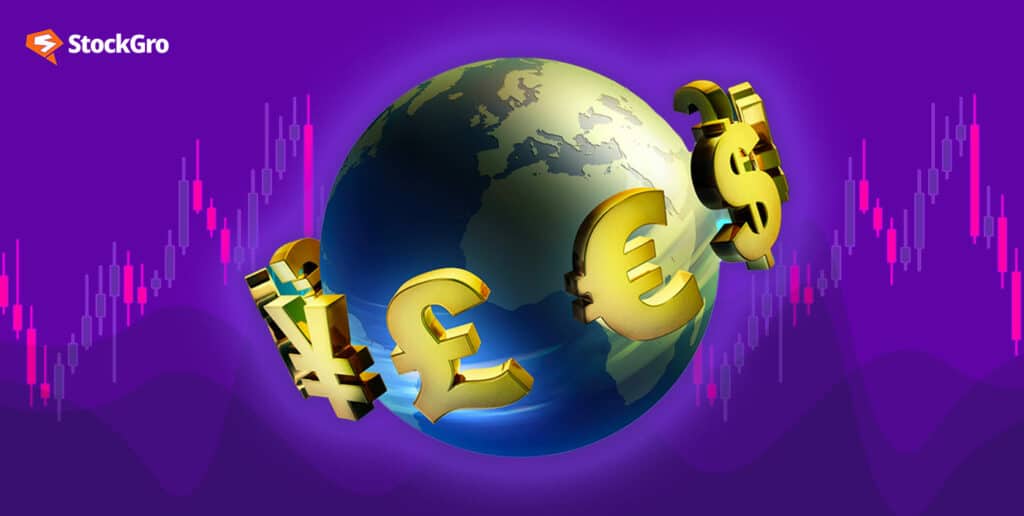
The US dollar, once the ruler of the financial world, is facing tough competition as countries seek alternatives. Its market share in global forex reserves hit a 27-year low in 2022, standing at around 58%. That’s a big drop!
While the dollar takes a hit, central banks worldwide are turning to gold as a safe haven. In 2022 alone, they bought a staggering 1,126 tonnes of gold—the highest amount since 1950. Countries are also exploring settlement options for trade and investments using their currencies or third-party alternatives, bypassing the dollar.
Currency fluctuations are a rollercoaster ride driven by factors like inflation, interest rates, geopolitical stability, trade balances, public debt, and economic well-being. But what do these fluctuations mean? How do they affect the market? And most importantly, how do they impact your investments?
Let’s break it down and unveil the impact of currency fluctuations on your investment portfolio:
The mighty Dollar vs. the Rest
The foreign investor factor
A stronger economy waltzes with a stronger currency. When a country’s economy booms, its currency gets a power boost, and global investors can’t resist hitting the dance floor of that country’s stock market! They buy assets using the country’s currency, and it’s a boon for investments.
Foreign exchange rates play a crucial role here. Imagine one dollar equaling 81 rupees. If the rupee weakens to 83, it means we need 2 extra rupees to buy one US dollar. This impacts foreign investors, who may see a decrease in the value of their investments in a country with a weaker currency, especially when converted back to their home currency.
You may also like: How is generative AI affecting the financial industry?
Currency clash in your portfolio
Now, let’s imagine you invested in US stocks, and suddenly, the Rupee whispers about its growing strength against the dollar. Exciting, right? Well, not exactly. While your investment in Rupees may shine with delight, the overall return might dip because it’s tied to a US company.
How does it affect retail investors?
Currency fluctuations can indirectly affect your investments, even if you only hold domestic assets:
1. Mutual Funds
If you’ve invested in mutual funds that have holdings in foreign stocks or bonds, currency shifts can make or break your investment. When the dollar flexes its muscles, your foreign mutual funds might start dancing with joy, increasing in value. But if the dollar weakens, your investment might stumble and lose its shine.
2. Domestic Investments
Domestic investments aren’t immune to currency swings either. Imagine an Indian company importing raw materials from the U.S. If the dollar strengthens against the Rupee, their expenses increase, denting their net profit.
This poor financial performance can spill over to the company’s stock performance, affecting your investment portfolio.
Even if you stick to domestic assets, currency risks can still sneak up on you through the global market. Many companies listed on the stock market have investments in foreign companies. So, if the currency of those countries takes a nosedive, it can drag down your investments too.
Also Read: ICICI Bank’s surprise move: Delisting ICICI Securities
The dollar defensive and aggressive stocks
Currency fluctuations impact different sectors in contrasting ways: Your investment playground can be full of dollar-defensive and dollar-aggressive stocks.
Dollar defensive stocks:
Companies in sectors like IT and pharma benefit from a weaker rupee, as it boosts their profitability.
For example, consider an IT company that provides software services to clients abroad. When the rupee falls in value, the company receives more rupees for every dollar earned. This boosts their profitability and can lead to higher stock prices.
Similarly, pharmaceutical companies that export medicines benefit from a weaker rupee, as it improves their profit margins. So, in this currency game, these dollar defensive stocks play to win when the rupee falls.
Dollar aggressive stocks:
On the other side, we have dollar-aggressive stocks. These companies face challenges when the rupee weakens, especially if they rely on borrowing or have high import costs.
Let’s say there’s a manufacturing company that imports raw materials from abroad, and the majority of its expenses are in dollars. If the rupee falls, the company has to pay more rupees to cover its dollar-denominated expenses. This can squeeze their profit margins and negatively impact their stock performance.
So, in this currency game, these dollar-aggressive stocks face challenges when the rupee falls.
Commodity Chaos
Commodities like oil, gold, and copper are globally priced in US dollars. So, when the dollar wobbles, it can shake up commodity prices. A weak dollar means you need more of it to buy the same amount of a commodity, leading to higher prices.
This ripples through sectors like energy, manufacturing, and transportation, squeezing profit margins and potentially lowering stock prices.
Crude prices and inflation
With India importing 80% of its oil, any rise in crude prices due to currency depreciation affects industries heavily reliant on oil.
Industries like paint and chemicals suffer as the landed cost of crude skyrockets, squeezing their profit margins. And since these companies are part of your portfolio, their struggles become yours too.
Gold prices
Any change in the dollar’s value sends ripples through the world of gold. And guess what? Many Indian investors hold a sizable chunk of gold in their portfolios, making its fate a matter of great importance.
The Euro’s challange
With the emergence of the Euro, the dollar no longer reigns supreme in global trade. Less than half of global trade is now invoiced in dollars. It’s making its mark in the world of global payments!
Also Read: El Nino: A threat to India’s economy
| % Share of currencies in global payments | |
| USD ($) | 40.1 |
| Euro (€) | 37.9 |
| British Pound (£) | 6.6 |
| Japanese yen (¥) | 3.2 |
| Chinese Yuan (¥) | 1.9 |
| Canadian Dollar (C$) | 1.7 |
| Australian Dollar (A$) | 1.3 |
Remember, currency fluctuations can make or break your investments. With a well-balanced strategy, you can navigate the ups and downs and come out on top!

